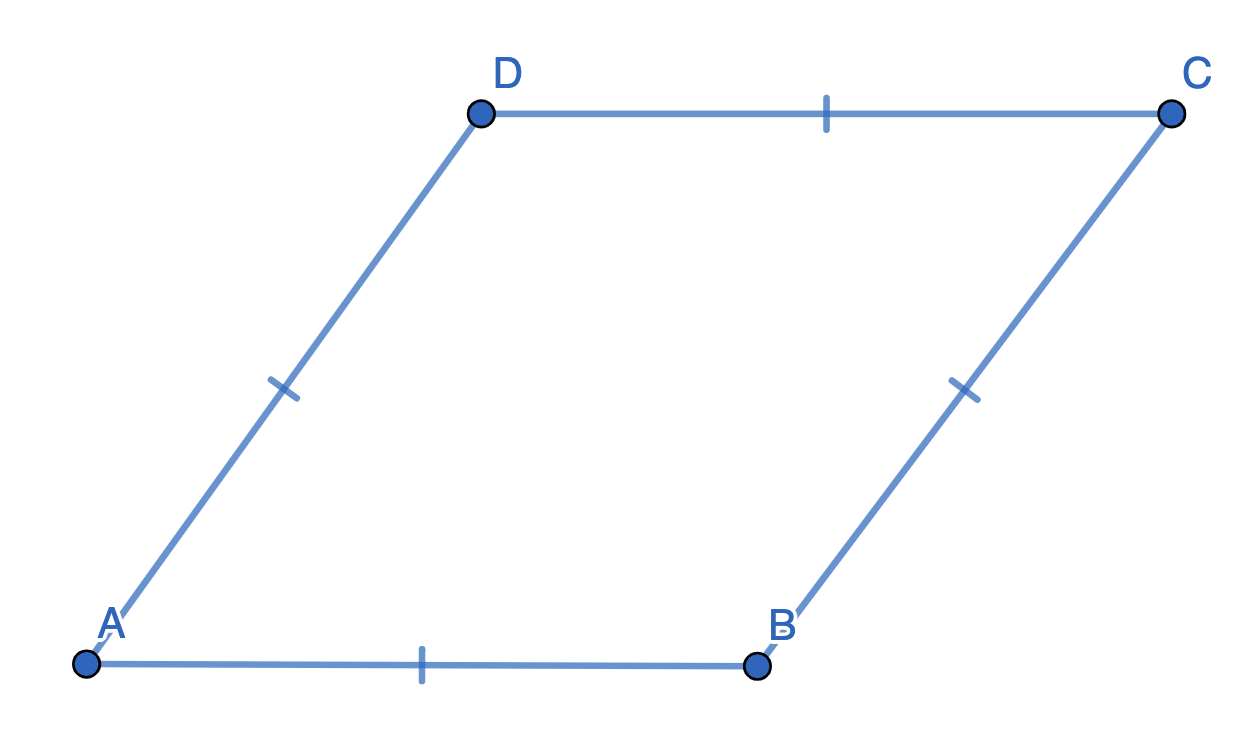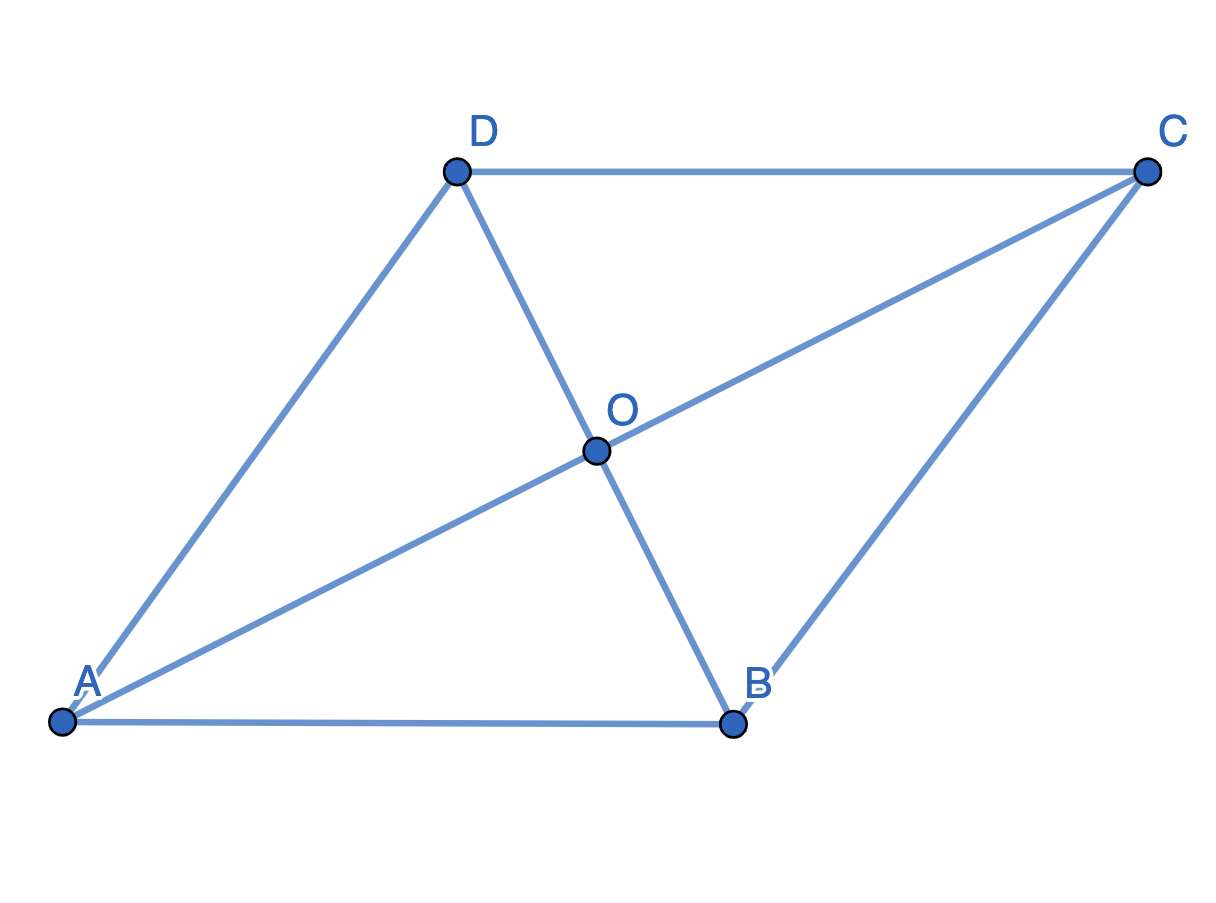Rhombuses meaning
- A rhombus is a quadrilateral with all sides equal in length and two pairs of parallel sides.
- A quadrilateral is any four-sided shape.
- A parallelogram is any quadrilateral with two pairs of parallel sides.
A quadrilateral with 2 pairs of parallel opposite sides is called a parallelogram.
From the definition of the rhombus and parallelogram, we see that all rhombuses are special types of parallelograms, since they have two pairs of parallel sides. It is helpful to be familiar with parallelograms for the purposes of this article.
The following figure illustrates a rhombus, . Since it is a rhombus, all of its sides are of equal length.

Rhombus illustration - StudySmarter OriginalsFrom the figure of ABCD, we have:
Since a rhombus is a type of parallelogram, the opposite sides are parallel. Thus, is parallel to and is parallel to .
Properties of rhombuses
Now that we have discussed the basic characteristics of a rhombus, let's consider its properties in more detail.
Rhombuses as parallelograms
We have mentioned that rhombuses are a special type of parallelogram, so we can say that all the properties of parallelograms apply to rhombuses as well. Let's see how the properties of parallelograms in general apply specifically to rhombuses:
Both pairs of opposite sides of a rhombus are parallel.
Opposite angles of a rhombus are equal.
The diagonals of a rhombus bisect each other. In other words, the intersection of the two diagonals is at the mid point of each diagonal.
Each diagonal of a rhombus divides the rhombus into 2 congruent triangles.
Properties unique to rhombuses
In addition to the properties concerning parallelograms, there are also additional properties specific and unique to rhombuses. We will describe this with reference to the rhombus ABCD below:

Rhombus illustration with diagonals shown - StudySmarter Originals- The diagonals of a rhombus are perpendicular to each other. This means they are at right angles to each other.
- Thus, in the diagram above, .
- From this, we could also say that
- Each diagonal of a rhombus bisects a pair of opposite interior angles.
- In other words, and
- The four triangles created when we add in the rhombus diagonals are congruent. So, they are mathematically identical but just oriented differently.
The congruent triangles of rhombuses
From the properties of rhombuses, we know that its diagonals divide the shape into four triangles that are congruent. What does it mean for triangles to be congruent? Two or more triangles are congruent if they are mathematically identical. In other words, all of the sides and angles are the same, even if they are oriented differently. Also recall that the internal angles in a triangle sum to 180 degrees.
Consider the rhombus below. Prove that for the given rhombus, AC ⊥ BD.
The mathematical symbol ⊥ means "perpendicular to."

Rhombus example - StudySmarter OriginalsSolution:
By the definition of a rhombus:
Now consider the triangles and :
The side is a side of both triangles. Now, , since is a rhombus. We also have , since is also a parallelogram and the diagonals of a parallelogram bisect each other. Therefore, triangle is congruent to triangle . In other words, they are exactly the same triangles, just rotated in different positions.
This implies that:
Additionally, and lie on the same straight line. Thus,
Therefore,
Similarly we can show that:
Thus, and are perpendicular. That is, .
Area formula for rhombuses
We have a specific formula to find the area of a rhombus. Consider the following rhombus:

Rhombus example - StudySmarter OriginalsNow, let's label the diagonals such that and .
The area of the rhombus is given by the formula:
Since a rhombus is a type of quadrilateral, we also have an alternative formula for finding the area.
The area of any quadrilateral is given by the formula:
So, depending on what lengths we have, we can use either of the above formulas to work out the area of a rhombus.
Note that when we discuss area, we use square units. For example, if the lengths of the base and height are given both in centimeters, the units for the area are centimeters squared ().
A rhombus has diagonals of lengths and . What is the area of the rhombus?
Solution:
Using the specific formula for the area of a rhombus, we have:
Substituting in and , we have:
Thus, the area of this rhombus is .
Further rhombuses examples
Now we will look at some further example problems on rhombuses.
Consider the below rhombus. Given that , find .

Rhombus example - StudySmarter Originals
Solution:
Recall that in a rhombus, each diagonal bisects, which means that we have a pair of equal angles. We also know that opposite angles in a rhombus are equal.
Thus,
Now, we mentioned earlier that the diagonals in a rhombus are perpendicular to each other. Therefore,
Since forms a triangle, and angles in a triangle sum to , we can work out :
So, substituting in the known angles, we have
which implies that
Subtracting from both sides, we obtain:
So, we have that .
Consider the following rhombus depicted below. Given that , find .

Rhombus example - StudySmarter OriginalsSolution:
Recall that diagonal bisects . Therefore, we have,
.
We also have that due to the perpendicular bisector.
So, since angles in a triangle sum to , we have:
.
Thus, .
Rhombuses - Key takeaways
- A rhombus is a special quadrilateral with all four sides equal in length and two pairs of parallel sides.
- A parallelogram is any quadrilateral with two pairs of parallel sides, so a rhombus is also a parallelogram.
- Opposite angles of a rhombus are equal.
- The diagonals of a rhombus bisect each other. In other words, the intersection of the two diagonals is at the midpoint of each diagonal.
- The diagonals of a rhombus divide the shape into four congruent right-angled triangles.
- The area of a rhombus is given by where and are the diagonals.









